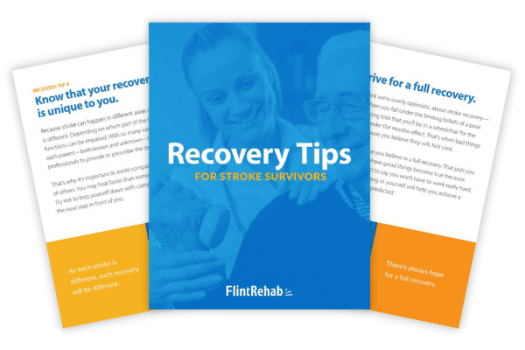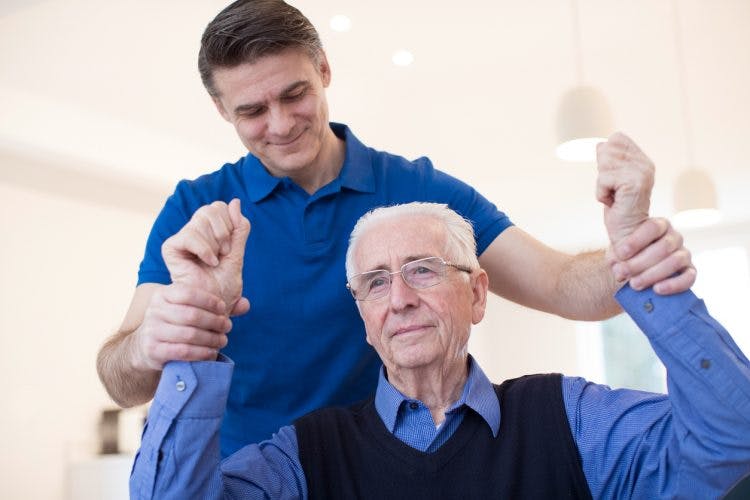How to Overcome Flaccidity After Stroke and Regain Movement
Flaccidity after stroke often occurs in the early days of stroke rehabilitation, but in extreme cases it can continue. It refers to a complete lack of voluntary movement caused by damage to the neural pathways in the brain.
To help you better understand this stroke effect, you’re about to learn the causes and treatments for flaccid paralysis. Let’s begin.
What is Flaccidity After Stroke?
Flaccidity (also known as flaccid paralysis) after a stroke corresponds to the first stage in the Brunnstrom Stages of Stroke Recovery. For some stroke survivors, this is the initial period immediately following a stroke.
However, not all stroke survivors will demonstrate complete flaccidity even immediately after their stroke. On the contrary, some will have flaccidity that lasts beyond the very initial period after stroke, as every stroke is so different.
After a stroke, the neural connections between the brain and the muscles can be compromised. In severe cases, the messages that the brain normally sends to the muscles can no longer get through, leaving the muscles effectively paralyzed.
When a person has flaccid paralysis, they cannot initiate any voluntary movement on their affected side.
If flaccidity lasts too long without treatment, the muscles can begin to atrophy. Flaccidity is also often associated with low muscle tone (hypotonia) after stroke.
Hypotonia and Flaccidity

Hypotonia refers to the low muscle tone that can occur because of injury to the brain like a stroke (among other causes). Normal muscles will have a small amount of contraction even when they’re relaxed, however this does not occur with hypotonia.
Low muscle tone often co-exists with muscle weakness and numbness and can also increase a person’s risk of injury to the affected body parts. That’s why it is important for caregivers to help kickstart the patient’s natural healing process before hypotonia gets too severe.
Fortunately, there are many ways to do that, which we will cover in a moment.
How Long Does Flaccidity After Stroke Last?
Because every stroke is different, it is not possible to predict how long flaccidity will last for each individual.
For some people, their flaccidity will fade after a few days as their brain begins to heal. For others, their paralysis can last several months before they see improvements.
But because of the brain’s natural ability to rewire itself (called neuroplasticity) it’s possible to encourage the brain to re-establish its connection to the muscles and overcome flaccidity after stroke.
Treatments for Flaccid Paralysis
Neuroplasticity refers to the brain’s ability to rewire neural pathways. These new pathways allow undamaged portions of the brain to take control of functions from damaged areas.
Normally, the most effective way to activate neuroplasticity is through intensive rehab exercise.
However, for obvious reasons, that is not possible when you have flaccid paralysis. But fortunately, there are still ways to engage neuroplasticity even when you can’t move your muscles.
The following are a few effective ways to help your muscles wake up in order to start minimizing flaccidity.
1. Passive Range-of-Motion
Passive exercises can help you maintain range of motion and regain control of your muscles. During passive exercises, a therapist moves your muscles for you, or you move them yourself using your non-affected arm.
Make sure you avoid moving your arm into a painful position. Since you may have sensory loss along with flaccidity, you might not be able to tell if you are pulling the muscle wrong. Have your physical or occupational therapist show you the correct movements before trying them at home.
Even though you technically aren’t activating the muscle, having someone else do the motion is enough to stimulate the brain and rekindle the neural networks that help you move. Additionally, these exercises will help to keep your joints mobile while your arm is in the flaccid state.
2. Mirror Therapy

Mirror box therapy utilizes a tabletop mirror to create a reflection of the patient’s arm or hand.
To practice this therapy, place your unaffected limb outside the mirror box and your flaccid arm inside the box. Next, start doing hand therapy exercises with your non-paralyzed hand, while focusing your vision on the reflection in the mirror.
When you look at the box, you will see your good hand moving in the place where your flaccid arm should be. This simulated visual feedback activates mirror neurons in the premotor cortex, the part of the brain that controls movement.
In other words, mirror therapy essentially tricks the brain into thinking it is moving your flaccid hand, which in turn activates neuroplasticity.
3. Electrical Stimulation
Electrical stimulation is another excellent way to re-link your muscles to your brain. It works by sending an electrical impulse directly to your affected muscles, causing them to contract.
Studies have shown that e-stim can actually prime the motor cortex and make neuroplasticity more effective.
Combine electrical stimulation with passive exercise to get the best results. The more you stimulate your brain like this, the better its link with your muscles will be.
Other effective ways to stimulate your muscles include tapping the muscles you want to activate and quick stretches. Have your therapist show you how to engage in e-stim, muscle tapping, and quick stretching in order to make sure you are using these techniques safely and properly.
4. Mental Practice

Along with passive exercise, mentally visualizing yourself moving your flaccid muscles can also activate neural plasticity.
Therapists call this mental practice, and several studies have shown that it engages the same brain regions as physical movement.
This, therefore, makes mental practice a great way to reconnect your mind to your muscles and overcome flaccidity after stroke. It’s something you can easily practice at home on your own too.
Once again, for the best results, combine mental practice with passive range of motion exercises.
While your therapist or caregiver moves your arm, watch the arm move and imagine you are moving it yourself. This can boost neuroplasticity and help you recover full movement faster.
5. Active Exercise
The more you use the therapies suggested above, the more the connection between your brain and muscles will grow.
Eventually, you should regain minimal movement in your affected limb. For example, you may start to see twitches in your arm or hand. When this occurs, you’ll want to take immediate advantage.
Therefore, even if you can only move a few centimeters at a time, you must start practicing repetitive, active exercises to reinforce your neural connections.
One of the best ways to get yourself to accomplish high repetition of rehab exercises is to use FitMi home therapy. This device helps patients engage their entire body, including their hands, arms, and core.
FitMi is the reason one patient with flaccidity after stroke was able to move his arm for the first time after only three weeks of exercise.
Overcoming Flaccidity After Stroke
Flaccidity after stroke can be a hard period to deal with. However, for most people, this stage does not last very long. With time, you should enter the second phase of stroke recovery, where flexion synergy patterns occur.
But to minimize muscle atrophy in the meantime, you can hasten through the exercises in this article.
The more you stimulate your muscles, the more you can reinforce communication between your mind and muscles and regain functional movement.
Keep It Going: Download Our Stroke Recovery Ebook for Free

Get our free stroke recovery ebook by signing up below! It contains 15 tips every stroke survivor and caregiver must know. You’ll also receive our weekly Monday newsletter that contains 5 articles on stroke recovery. We will never sell your email address, and we never spam. That we promise.
